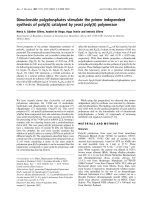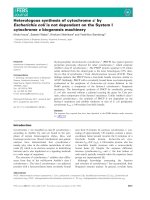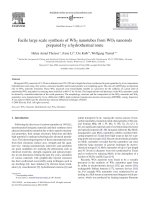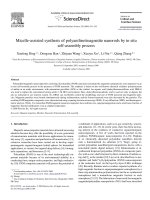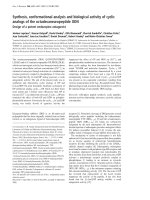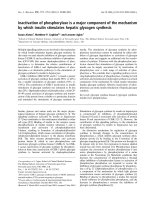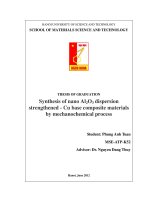Synthesis of Cyclic βPeptidomimetics by Ring Closing Metathesis
Bạn đang xem bản rút gọn của tài liệu. Xem và tải ngay bản đầy đủ của tài liệu tại đây (1.13 MB, 43 trang )
VIETNAM NATIONAL UNIVERSITY, HANOI
VNU UNIVERSITY OF SCIENCE
FACULTY OF CHEMISTRY
----------
Trần Thị Minh Châu
Synthesis of Cyclic β-Peptidomimetics by
Ring Closing Metathesis
Submitted in partial fulfillment of the requirements for the course of
CHE4050 in Chemistry
(Advanced program in Chemistry)
Hanoi - 2021
i
VIETNAM NATIONAL UNIVERSITY, HANOI
VNU UNIVERSITY OF SCIENCE
FACULTY OF CHEMISTRY
----------
Trần Thị Minh Châu
Synthesis of Cyclic β-Peptidomimetics by
Ring Closing Metathesis
Submitted in partial fulfillment of the requirements for the course of
CHE4050 in Chemistry
(Advanced program in Chemistry)
Supervisor: Assoc. Prof. Mạc Đình Hùng
Hanoi - 2021
ii
Acknowledgement
Firstly, I would like to express deep gratitude to my supervisor, Assoc. prof.
Mac Dinh Hung for accepting me in Medicinal Chemistry laboratory, as well as
supervising and supporting my work throughout these past 4 years. Throughout
this journey, I have gained a lot of invaluable theoretical and practical knowledge
from him.
I would like to show my appreciation towards Dr. Nguyen Hoang Yen for
being a great source of support and encouragement throughout my senior year. I
wish to express my sincere gratitude to To Dong Quang and Le Quy Hien for
always provide considerable assistance for any problems I encountered during my
study at university. I would like to extend my appreciation to my laboratory
members for helping me and making the time I worked here enjoyable.
Finally, I am profoundly grateful for the great support of my family. I am also
thankful for all of my friends especially, Nguyen Doan Thu Thuy and Pham Anh
Thu, for always being there for me.
i
Table of contents
Acknowledgement................................................................................................... i
Table of contents .................................................................................................... ii
List of figures and schemes ................................................................................... iv
List of abbreviation ............................................................................................... vi
Chapter 1: General Introduction ............................................................................ 1
Chapter 2: Literature Review ................................................................................. 3
2.1. Overview of peptides ................................................................................... 3
2.1.1. Proteins and amino acids ....................................................................... 3
2.1.2. Protein-protein interaction ..................................................................... 4
2.1.3. Mediating protein-protein interactions .................................................. 5
2.1.3.1. Peptides as drugs ........................................................................... 5
2.1.3.2. Disadvantages of peptides ............................................................ 5
2.2. Overview of peptidomimetics ...................................................................... 6
2.2.1. Peptidomimetics..................................................................................... 6
2.2.2. Classification of peptidomimetics ......................................................... 7
2.2.3. Synthetic approaches towards peptidomimetics design ........................ 7
2.2.3.1. Side chain modification ................................................................ 8
2.2.3.2. Strategies for restriction of φ, ψ, and ω torsion angles ................. 9
2.2.3.2.1. Backbone modification .......................................................... 9
2.2.3.2.2. Introduction of global restriction ......................................... 11
2.3. Ring closing metathesis route to cyclic β-peptidomimetics ...................... 12
2.3.1. A brief history of metathesis................................................................ 12
ii
2.3.2. Peptidomimetics by ring closing metathesis ....................................... 13
2.3.3. Peptidomimetics from β-amino acids .................................................. 15
2.4. Research described in this thesis ............................................................... 18
Chapter 3: Experimental Method ......................................................................... 19
3.1. Subject and purpose ................................................................................... 19
3.2. Experimental procedure ............................................................................. 19
3.2.1. Materials .............................................................................................. 19
3.2.2. N-alkylation procedure ........................................................................ 20
3.2.3. Amide coupling procedure................................................................... 21
3.2.4. Ring closing metathesis procedure ...................................................... 21
Chapter 4: Results and Discussions ..................................................................... 23
4.1. Synthesis of N-alkylated β-amino acid ...................................................... 23
4.2. Synthesis of cyclic β-peptidomimetic ........................................................ 25
Chapter 5: Conclusion .......................................................................................... 27
Reference .............................................................................................................. 28
iii
List of figures and schemes
A. Figures
Figure 1 General structure of an α-amino acid. ..................................................... 4
Figure 2 Dihedral angles that define peptide structure. The backbone is defined
by φ, ψ, ω, the side chain geometry is defined by 𝜒 .............................................. 7
Figure 3 Newman projections of low energy staggered conformers in α-amino
acids. ....................................................................................................................... 8
Figure 4 Natural phenylalanine and β-alkyl analogue 1.01. .................................. 8
Figure 5 Structure of tera-substituted Aib. .......................................................... 10
Figure 6 The three principles arrangements of peptide cyclization. .................... 11
Figure 7 Hormones containing a disulfide bridge................................................ 12
Figure 8 Ring closing metathesis mechanism. ..................................................... 12
Figure 9 An early example of the use of RCM to mimic a disulfide bond.......... 13
Figure 10 Recent peptidomimetics cyclized by RCM. ........................................ 14
Figure 11 Examples of bi-cyclics lactams where RCM is facilitates cyclic
constraint. ............................................................................................................. 16
Figure 12 Top: RCM is not possible with a trans-amide as the diene groups are
too far apart for the intramolecular reaction. Bottom: the DMB group stabilizes
the cis geometry of the amide bond facilitating RCM. ........................................ 17
Figure 13 Cyclization of Cβ-N’ by RCM to give 8-membered ring 1.17............ 17
B. Table
Table 1 The most common forms of backbone modification of peptides to create
peptidomimetics. .................................................................................................... 9
C. Schemes
Scheme 1 Synthesis scheme ................................................................................. 19
Scheme 2 Synthesis of mono-alkylated product .................................................. 20
Scheme 3 Amine protection. ................................................................................ 21
iv
Scheme 4 Synthesis of dienes .............................................................................. 21
Scheme 5 Ring closing metathesis reaction ......................................................... 22
v
List of abbreviation
Bn
Et
Me
Boc
Cbz
RCM
DCM
DMF
EDCI. HCl
HOBt
UV
NMR
equiv.
temp
h
r.t.
TLC
: benzyl
: etyl
: methyl
: tert-butoxycarbonyl
: carboxybenzyl
: ring closing metathesis
: dichloromethane
: dimethylformamide
: 1-(3-dimethylaminopropyl)-3-ethylcarbodiimide hydrochloride
: hydroxy benzotriazole
: ultraviolet
: Nuclear Magnetic Resonance
: equivalent
: temperature
: hour(s)
: room temperature
: thin-layer chromatography
vi
Chapter 1
General Introduction
More than 7000 naturally occurring peptides have been identified, and these
compounds influence many important physiological mechanisms in the human
body, such as immune defense, metabolism, digestion, respiration and sensitivity
to pain [1]. Peptides are acknowledged for being highly selective and efficacious
as well as relatively safe and well-tolerated as therapeutics [2]. Due to these
advantages, an increasing number of peptides are entering clinical trials and being
approved as therapeutics: An approximate of 60 peptides are approved for human
use worldwide, and 140 therapeutic peptides are in different stages of clinical
development [1]. However, natural endogenous peptide sequences have intrinsic
weaknesses, including limited stability towards proteolysis, rapid excretion, poor
cell penatration and non-specific interactions with multiple targets [2].
The limitations associated with therapeutic peptides can be overcome by
modifying existing peptide sequences to create peptidomimetics. These molecules
are developed to display metabolic stability, good bioavailability, and enhanced
receptor affinity and selectivity [2]. Synthetic strategies focusing on optimizing
the structure of the lead peptide by introducing functional modifications are able
to address the intrinsic disadvantages of peptides, while maintaining the structural
features responsible for the biological activity [2].
A peptidomimetic approach that has extensive opportunities, is the use of βamino acids [3]. β-peptides differ from their natural counterpart, α-peptides, by
having a CH2 group inserted into every amino acid residue. As reported by
Seebach [4], the incorporation of an additional carbon would not increase the
number of the possible configurational isomers but rather it would enhance the
stability of the secondary structure comparing to their α-peptide counterparts. The
cyclization of β-peptides could potentially stabilize the bioactive conformation
and enhance its metabolic stability by introducing additional conformational
constraint [3].
1
Due to the significant potential of the incorporation of β-amino acids in
creating peptidomimetics, we have chosen to investigate the design of cyclic
peptide mimics. This study describes the efficient synthesis strategies of a
conformationally constrained peptidomimetic containing a 9-atom-membered ring
by ring closing metathesis.
2
Chapter 2
Literature Review
2.1. Overview of peptides
2.1.1. Proteins and amino acids
Proteins, also known as polypeptides, are one of the most abundant organic
molecules in living systems and have the most diverse range of functions of all
macromolecules. Each cell in a living system may contain thousands of different
proteins, each with a unique function. They can be component of the cell
membranes, enzymes and co-factors in cellular biochemical, and chemical
messengers for the human immune system.
The major building block of proteins are called α-amino acids (Figure 1) [5].
As the name implies, they contain a carboxylic acid functional group and an amine
functional group. The alpha designation is used to indicate that these two
functional groups are separated from one another by a single carbon group. In
addition to the amine and the carboxylic acid, the α carbon is also attached to a
hydrogen and one additional group that can vary in size and length. Within living
organisms there are 20 amino acids used as protein building blocks. They differ
from one another only at the R-group position.
3
Figure 1 General structure of an α-amino acid.
2.1.2. Protein-protein interaction
The function of proteins is largely controlled by regulation of protein-protein
interactions (PPI) [4]. Commonly they are understood as physical contacts with
molecular docking between proteins that occur in a cell or in a living organism in
vivo. The disruption of protein-protein interaction forms the basis of many
diseases either through the loss of an essential interaction, through the formation
of an undesirable interaction or through the host-pathogen interactions [6]. A
prominent example was the recent emergence of the novel, pathogenic SARScoronavirus 2 (SARS-CoV-2) causing the global coronavirus disease pandemic.
The binding between viral surface spike proteins and ACE2 (angiotensinconverting enzyme 2) receptors abundantly expressed on human lung alveolar
epithelial cell membranes triggers the fusion between cell and viral membrane,
leading to viral entry. Therefore, this host-pathogen PPI forms a critical initial step
for SARS-CoV-2 infection and its associated pathologies such as respiratory
syndrome [7]. As such the design of molecules that can bind to the relevant site of
proteins to act as agonists or antagonists and remove undesirable physiological
symptoms is an important area of drug design [8].
4
2.1.3. Mediating protein-protein interactions
2.1.3.1. Peptides as drugs
Peptides are ideal candidates for inhibition of protein-protein interactions
because they can mimic a protein surface to effectively compete for binding [9].
Additionally, peptides are synthetically accessible and can be stabilized by
chemical modifications. It is estimated that between 15% and 40% of all cellular
interactions are mediated through PPI [10]. Peptides can be rationally designed
based on the natural sequences that mediates PPI in the proteins, and therefore can
mask a critical part of the binding surface; furthermore, peptides can modulate
intracellular targets by crossing the cell membrane independently or via
conjugation to cell-penetrating vehicle peptides [11].
Insulin was the first therapeutic peptide to be isolated and has been
administered for treatment of diabetes since 1922 [12]; however, it was not until
the pioneering work of du Vigneaud in the early 1950’s on sequencing and
synthesizing oxytocin and vasopressin [13], that the field of synthetic
pharmaceutical peptides became truly viable. The use of naturally occurring or
novel peptides to interact with proteins as therapeutics is now commonplace with
approximately 60 peptide-based drugs currently on the market, covering a broad
range of pathologies such as, diabetes, gastrointestinal disorder, osteoporosis,
cancers, bacterial and fungal infections [2]. Most therapeutics peptides are
receptor agonists, and generally, only small percentages of receptors (5-20%)
require peptide occupancy to elicit a desired effect [14].
2.1.3.2. Disadvantages of peptides
Despite intense interest since the 1950’s, natural endogenous peptides are
often not directly suitable for use as convenient therapeutics due to their
unfavorable physicochemical properties [15]. Such structures can have limited
stability towards proteolysis, resulting in a half-life in the order of minutes in
5
serum [16]. Due to the relatively high molecular mass of these molecules and lack
of specific transport systems, they show poor absorption and transport properties,
often resulting in a rapid excretion through the liver and kidneys. They interact
with multiple targets, resulting in poor selectivity and undesired side effects, due
to the intrinsic flexibility imparted by the N-Cα and Cα-CO rotatable bonds of each
amino acid. Additionally, given that oral administration leads to rapid degradation
in the digestive system, many peptide therapeutics are administered via parenteral
injections [2].
2.2. Overview of peptidomimetics
2.2.1. Peptidomimetics
Peptidomimetics have been defined as ‘compounds whose essential elements
mimic a natural peptide or protein in 3D space and which retain the ability to
interact with the biological target and produce the same biological effect’ [17].
Apart from being much more selective and efficient than native peptides, thus
resulting in fewer side effects, peptidomimetics show greater oral bioavailability
and prolonged biological activity due to smaller extent of enzymatic degradation
[2]. The generation of peptidomimetics is based on knowledge of the electronic
and conformational features of the native peptide and its receptor or embedding
site [18]. Thus, the development of peptidomimetics as compounds with potential
biological activity must take account of some basic principles [19], including:
• Replacement of peptide backbone with a non-peptide framework.
• Preservation of sidechains involved in biological activity, as they constitute
the pharmacophore.
• Maintenance of flexibility in first-generation peptidomimetics.
• Selection of proper targets based on a pharmacophore hypothesis.
An important goal in the development of rationally designed mimics is to
restrict the backbone and the side chain moieties into protein secondary structure
6
motifs (e.g., α-helix, β-strand or β-turn) [20]. These structures are defined by their
φ (phi), ψ (psi) and ω (omega) angles, while the side chain geometry is defined by
𝜒 (chi) space (Figure 2).
Figure 2 Dihedral angles that define peptide structure. The backbone is defined by φ, ψ, ω, the
side chain geometry is defined by 𝜒.
2.2.2. Classification of peptidomimetics
Peptidomimetics may be divided into three types depending on their structural
and functional characteristics [2]:
• Type I mimetics, or structural mimetics, show a strict analogy with the native
substrate, as they carry all the functionalities in the same spatial orientation.
• Type II mimetics, or functional mimetics, do not show apparent structural
analogies with the native substrate, but are able to mimic its function by interacting
similarly with the target receptor or enzyme.
• Type III mimetics, or functional-structural mimetics, possess a scaffold
significantly different from the native substrate, while displaying the interacting
elements in the same spatial orientation.
2.2.3. Synthetic approaches towards peptidomimetics design
There are several different approaches for the generation of peptidomimetics.
The selection of the design strategy depends on what is known about the target
protein in terms of structure, sequence, function, and the protein-binding site
characteristics. Herein, synthetic strategies aim to restrict the φ, ψ, ω, and 𝜒 angles
of peptidomimetics will be discussed. Broadly, these can be classified into three
7
categories, side chain modification, backbone modification, and introduction of
global restrictions.
2.2.3.1. Side chain modification
The side chain orientation of an α-amino acid is critical for molecular
recognition and transduction processes [21]. There are three low energy staggered
conformations that are possible (Figure 3).
Figure 3 Newman projections of low energy staggered conformers in α-amino acids.
In the gauche (-) conformation, the side chain points towards the N-terminus,
in the gauche (+) conformation the side chain is perpendicular to the peptide
backbone and in the anti-conformation the side chain points towards the Cterminus. Generally, all three conformations are accessible to a peptide due to the
low energy barrier between them; however, during interaction between a peptide
and its receptor, each side chain moiety will adopt the specific conformation
required for binding [22]. Fixing the side chain geometry by constraining the χ
angles is a powerful tool in the synthesis of peptidomimetics. Generally, side chain
modifications do not restrict the conformation of the peptide backbone [20].
Figure 4 Natural phenylalanine and β-alkyl analogue 1.01.
Side chain orientation can be constrained by alkylation of the β-carbon
(Figure 4). The rationale behind this is to isolate the biologically active χ rotomer
8
by steric hindrance of rotation about the χ1 bond [22]. β-carbon alkylation has been
used to modify a number of peptides including endogenous opioids [23], [24],
oxytocin [25], somatostatin [26], and glucagen [27] to investigate topographical
requirements and to better understand structure activity relationships.
Replacement of natural amino acids with their rigidified analogues can result in
higher activity and bio-stability. For example, when phenylalanine (Figure 4) is
replaced with 1.01 in a peptide, activity at opioid receptors is successfully
modified [28].
2.2.3.2. Strategies for restriction of φ, ψ, and ω torsion angles
2.2.3.2.1. Backbone modification
Extension of
Replacement of individual atoms
peptide chain
Replacement of
amide bond
Replace NH
Replace CH
Replace CO
X
Replace CO-NH
N-alkyl
N (aza)
CS
CH2
NH-CO
O
C-alkyl
CH2
O
CH(OH)CH2
S
BH
SOn (n=1,2)
NH
CH=CH
P=O(OH)
CH2CH2
P=O(OH)-CH2
Table 1 The most common forms of backbone modification of peptides to create
peptidomimetics.
The most common forms of backbone modification are given in Table 1.
These modifications generally reduce the mimic’s affinity to proteolytic cleavage
and, in some cases, restrict the flexibility of the backbone.
9
Backbone modification may involve replacement of individual atoms,
extension of the peptide or replacement of the amide bond. When considering
replacement of individual atoms, the NH, the CH or the carbonyl/amide bond can
be replaced to improve cell permeation and bio-stability properties or to restrict
the flexibility of the peptide. Replacement of the NH with an N-alkyl substituent,
which generally restricts the φ torsion angle while eliminating any hydrogen
bonding from the amide bond can increase membrane penetration and proteolytic
stability [5],[20]. There are naturally occurring examples of peptides with Nalkylation, such as, Cyclomarin C, an anti-inflammatory cyclic heptapeptide [29],
and this is a common tool for creating synthetic peptidomimetic libraries to probe
structure activity relationships. Due to the removal of hydrogen bonding ability
from the nitrogen after N-methylation, successive alkylation of each backbone NH
and subsequent measurement of biological activity for each derivative allows key
hydrogen bonds for activity to be identified [30].
As first observed by Thorpe and Ingold and colleagues [31], carbonsubstitution is an effective method to restrict the conformation of a molecule to
facilitate ring closure. Since early observations on the Thorpe-Ingold effect,
alkylation of the α-carbon have been extensively studied as a strategy for
peptidomimetic development due to the reduced rotation α-alkyl amino acids have
around the φ and ψ torsion angles [32]. The simplest example of a tetra-substituted
amino acid is naturally occurring α-aminoisobutyric acid (Aib) shown in Figure
5 [32].
Figure 5 Structure of tera-substituted Aib.
2.2.3.2.2. Introduction of global restriction
The introduction of global restrictions on peptide conformation by cyclization
is a recognized universal method for the preparation of peptidomimetics [20]. The
10
introduction of rigid bridges, of varying lengths between different parts of a
peptide, can improve potency by fixing the backbone torsion angles and/or side
chain orientation, locking the ligand into a preferred bioactive conformation.
There are three principal approaches to generating a cyclic peptidomimetic:
through backbone-backbone (including head to tail), backbone-side chain or side
chain-side chain cyclization (Figure 6). By far the most common method of
cyclization has been the formation of a disulfide bridge or by lactamization [33].
Numerous examples of natural cyclic peptides are known which contain either an
amide linkage or a disulfide bridge – somatostatin, oxytocin, vasopressin
ciclosporin and cyclotides to name a few [34-36]. Given nature’s propensity to
constrain peptides by these methods, it is not surprising that a number of
peptidomimetics, targeting a range of proteins, have been reported which contain
lactam or disulfide bridges [37], [38].
Figure 6 The three principles arrangements of peptide cyclization.
However, despite their ability to stabilize secondary structures, compounds
containing lactam and disulfide bridges do not make ideal peptidomimetics. The
lactam and disulfide bridges in natural systems and peptidomimetics are easily
recognized as substrates in vivo and are prone to degradation. Hormone oxytocin
and vasopressin (Figure 7) are limited in their therapeutic use by short in vivo
half-lives (2-5 mins) and must be administered intravenously [39].
11
Figure 7 Hormones containing a disulfide bridge.
2.3. Ring closing metathesis route to cyclic β-peptidomimetics
2.3.1. A brief history of metathesis
Ring closing metathesis has emerged as an efficient method for the synthesis
of carbon-carbon bonds in complex molecules including peptidomimetics. Ring
closing metathesis describes the process by which alkylidene groups of alkenes
exchange by the reversible mechanism proposed by Chauvin (Figure 8) [40],[41].
Figure 8 Ring closing metathesis mechanism.
Metathesis became a viable synthetic technique for organic chemists with the
development of air stable, functional group tolerant ruthenium catalysts,
12
specifically Grubbs’ first-generation catalyst [42]. The discovery of rutheniumbased catalysts in the early 1990s [43] has enabled ring closing metathesis to
become an important synthetic method in organic chemistry. Ruthenium catalysts
are generally less active than earlier transition metal catalysts and are therefore
more versatile for ring closing metathesis, reacting preferentially with olefins.
Compare this to molybdenum-, tungsten- and titanium-based catalysts which react
with other functional groups in the molecule including esters, amides, and ketones
[33]. The development of highly active, stable, second generation catalysts
capable of forming tri- and tetra- substituted olefins, has expanded the utility of
the ring closing metathesis reaction [44]. Grubbs’ second-generation catalyst is a
ruthenium-based system that has low sensitivity to moisture and air, which,
combined with the favorable combination of high alkene activity and functional
group compatibility, makes this the reagent of choice for olefin metathesis [33].
2.3.2. Peptidomimetics by ring closing metathesis
The first synthesis of a disulfide analogue by metathesis was reported by
Grubbs in 1996 (Figure 9) [45]. Here, cyclic tetra-peptide 1.03 was synthesized,
and subsequent conformational studies revealed the dicarba analogue displayed
the same hydrogen bonds, indicative of a β-turn, as the corresponding disulfide
1.02.
Figure 9 An early example of the use of RCM to mimic a disulfide bond.
Ring closing metathesis has been used to prepare peptidomimetics preorganized in all three of the key binding motifs discussed herein, specifically there
are α-helix mimics, β-turn mimics, and β-strand mimics reported.
13
Figure 10 Recent peptidomimetics cyclized by RCM.
The bond highlighted red indicates the alkene formed in metathesis.
Amylin (1-8) is an octa-peptide that is effective as a promoter of the
proliferation of osteoblasts (bone forming cells) which enhance bone volume and
strength. While Amylin is a potential treatment of osteoporosis, it is not stable in
vivo, due to a labile disulfide bridge, leading Kowalczyk and colleagues to
investigate replacing the disulfide bridge with dicarba analogues for example 1.04
(Figure 10) [46]. The dicarb analogues displayed biological activity
approximately equal to the parent peptide in in vitro assay and two of the most
promising analogues progressed to in vivo testing. While no mention of the
secondary structure of 1.04 is given, it should be noted that differences in
biological activity were observed when cis and trans isomers were compared. This
is presumably due to differing secondary structures imposed on the peptide by
either of the two olefin moieties.
Cyclic peptide 1.05 (Figure 10) was synthesized by Henchey et al to
investigate the helical forming properties conferred to an incorporating peptide
and to investigate the binding affinity to MDM2 [47]. P53 is a tumor suppressor
protein that signals cell apoptosis in response to DNA damage or cellular stress.
MDM2 binds to, and inhibits the action of, P53 at an α-helical interface. Inhibition
14
of P53 by MDM2 is implicated in cancer cell proliferation, so peptides that can
disrupt this interaction by binding to MDM2 may have potential as anticancer
agents. Peptidomimetic 1.05 was designed to replace a hydrogen bond with a
dicarba linkage to constrain the peptide in an α- helix conformation and displays
highly selective binding to the target MDM2. The propensity of mimic 1.05 to
adopt an α-helix is approximately double that of the parent peptide, and,
interestingly, the binding affinity of 1.05 to MDM2 compared to the parent peptide
is also approximately doubled (Kd = 160 nM compared to 340 nM).
2.3.3. Peptidomimetics from β-amino acids
Cyclic structures provide an important class of peptidomimetics that can
overcome many problems associated with linear peptides, including poor
bioavailability, low solubility, and low stability towards hydrolysis. The most
common classes of constrained β-turn mimics are the Freidinger lactams, spirobi- and tri- cyclic lactams, ring fused lactams including benzodiazepines and azabi
cycloalkanones and macrocycles comprised of di-, tri- and tetra- peptides [48],
[49]. Cyclic peptides comprised of β-amino acids are an emerging class of
peptidomimetics that have not been studied extensively yet but have potential as
β-turn mimics. Peptides comprised of β-amino acids are an attractive alternative
to those derived from α-amino acids in drug design due to their enhanced chemical
stability and hence improved resistance to degradation by enzymes in the body
[50]. Examples of β-peptides are known to form secondary structures such as,
turns, helices and sheets. These structures mimic those found in nature proteins;
however, β-peptides offer high stability while providing a scaffold for interaction
with α-amino acids [51].
Metathesis has gained enormous popularity as a strategy for making small and
large rings since the discovery of well-defined molybdenum and ruthenium
catalysts in the early 1990’s [52-54]. However, ring closing metathesis has only
15
relatively recently been used to successfully prepare medium sized rings, for
examples see Figure 11 [55-57] and Figure 12 [58-60].
Figure 11 Examples of bi-cyclics lactams where RCM is facilitates cyclic constraint.
Metathesis-mediated cyclization of medium sized rings have been achieved
by introducing a conformational constraint into the precursor diene, either by
using a cyclic constraint such as 1.06, 1.08 and 1.10 (Figure 11) [55-57] or acyclic
conformational constraint such as 1.14 shown in Figure 12 [58-60]. Much of the
ring closing metathesis research reported on β-turn mimics has focused on making
cyclic lactams from α-amino acids. For example, see 8-membered ring 1.15 shown
in Figure 12 [58-60].
16
Figure 12 Top: RCM is not possible with a trans-amide as the diene groups are too far apart
for the intramolecular reaction. Bottom: the DMB group stabilizes the cis geometry of the
amide bond facilitating RCM.
An example of an acyclic constraint is to introduce an N-alkylate on an amide
nitrogen with a 2,4-dimethoxy-benzyl (DMB) group. The DMB group stabilizes
the cis-amide conformation in the dipeptide shown in Figure 12 to facilitate RCM
[57-59]. Diene 1.12 does not undergo ring closing metathesis on treatment with
Grubbs’ second-generation catalyst, however diene 1.14, where the DMB group
favors a cis geometry about the central amide, is successfully cyclized to give 1.15.
Figure 13 Cyclization of Cβ-N’ by RCM to give 8-membered ring 1.17.
Finally, cyclization of 1.16 from Cβ to N’ gives Homo-Freidinger lactam 1.17
(Figure 13). Freidinger lactams are examples of conformationally restrained
peptidomimetics that are effective as inhibitors for a wide variety of proteases
[61]. Hoffmann and coworkers have used ring closing metathesis to produce
17
